MSI P55-GD80 - Pictorial Preview
by Gary Key on August 8, 2009 12:00 AM EST- Posted in
- Gary's First Looks
It must be snowing in Texas today as we finally have another P55 board to preview without it coming from Gigabyte or ASUS. Today's star is the MSI P55-GD80, which is designed to compete directly against the ASUS Deluxe and Gigabyte UD5 series. We have been very impressed with MSI as of late with the AMD based 790FX-GD70 plus the uATX form factor X58M motherboards. In fact, MSI will also be releasing a uATX based P55 motherboard that will sell under the P55M-GD45 moniker.
MSI was considerate enough to send us a production ready unit this week and we have had a blast using it since it hit the testbed. The P55-GD80 features MSI's "Xtreme Speed" initiative. This technological package consists of their OC Genie, SuperPipe, and DrMOS options that we will outline in detail at product launch. Along with these features are several others including Winki 2.0 (Linux core OS with several applications), USB Safeguard, OC Profiles, M-Flash, and U-key.
Truly, the OC Genie will be the one option that most impresses both the enthusiast and newbie when it comes to overclocking this board. OC Genie makes it a snap to overclock the board for beginners and has enough options in it for the enthusiast to squeeze that last little bit of performance out of the board. Of course the cooling advantages from the new SuperPipe (yes, we know the marketing glitz is heavy on this one) design will come into play as will the updated DrMOS power delivery system.
Board Layout
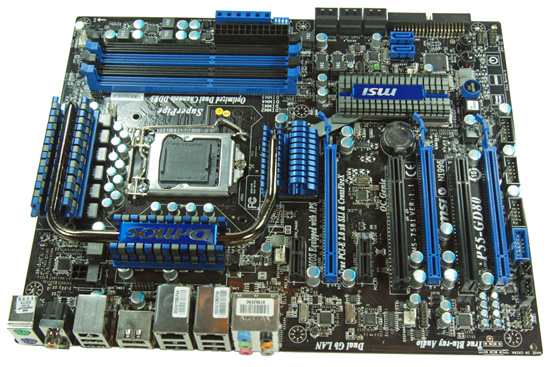
A quick view of the board finds an excellent layout that is designed for those who value expansion or multi-GPU capabilities. MSI utilizes the VIA VT6315N chipset for IEEE 1394a support, Realtek ALC 889a 8-channel HD audio codec, and dual Realtek 8112DL Gigabit LAN controllers. Why manufacturers continue to ignore the native Intel Gigabit LAN support in the P55 is beyond us.
The board also features 13 USB 2.0 ports (six headers/ seven ports on the I/O panel), an eSATA/USB combo power port, and support for up to 16GB of dual-channel DDR3 memory with standard BIOS support up to DDR3-2133. MSI includes power-on/reset/clear CMOS switches and a Debug LED panel for the open bench crowd.
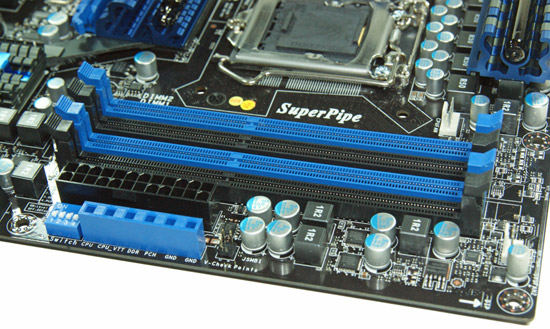
Right below the DIMM slots is MSI's new V-Kit option. The four pin switch header lets the user override the BIOS limits for VCore, VTT, DDR, and PCH values, which are already more than high enough to void warranties or damage your CPU. However, for those needing that extra voltage, these switches could come into play for extreme overclocks. A really nice feature for the OC crowd is the voltage check block that lets users measure actual voltages for VCore, VTT, DDR, and PCH values without have to run various leads around the board for a Digital Multimeter.
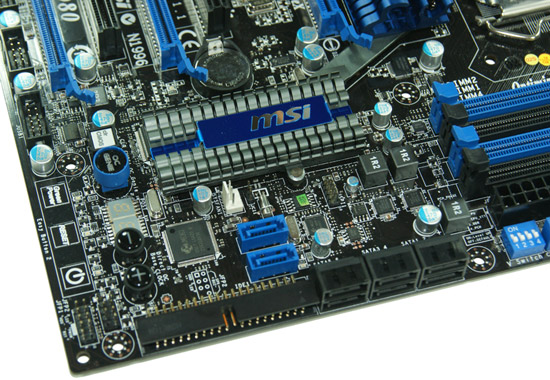
The P55-GD80 features six (black) SATA 3Gb/s ports provided by the P55 chipset that feature RAID 0, 1, 5, and 10 support along with Intel’s new version 9 Matrix Storage technology. The dark blue SATA connectors are powered by the JMicron JMB322 3Gb/s SATA chipset that feature RAID 0 and 1 support. The eSATA 3Gb/s port on the I/O panel and IDE port are provided by the JMicron JMB363 chipset.
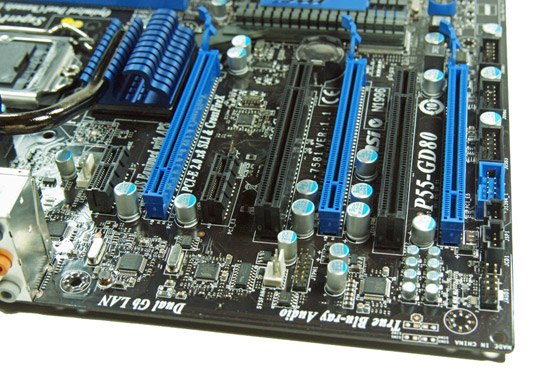
The board features two PCIe 2.0 x1 slots, two PCI slots, and three PCIe 2.0 x16 slots (x16/x4 or x8/x8/x4). The x4 PCIe slot (third one on the right) is provided by the P55 chipset and is not designed for optimal graphic’s performance. The layout of the PCI/PCIe slots is very good and allows for a single PCIe x1, PCIe x4, and PCI slot when running SLI or CrossFire.
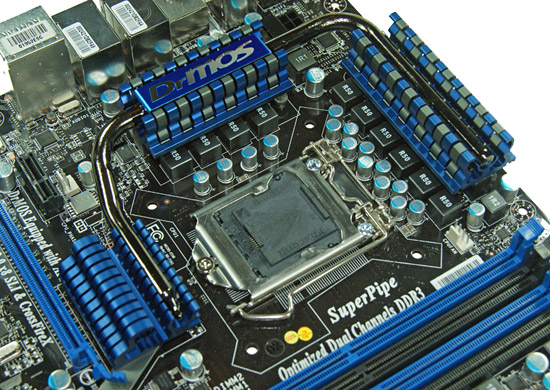
The CPU area is basically uncluttered and a push/pull CPU fan/heatsink design like the Vigor Monsoon III will not interfere with low-rise (heatsinks) memory in the first DIMM slot. The back of the board is clean and we expect various air/water coolers that require a back plate to work fine. We were hoping to see Socket 775 mounting holes on this board as an option. MSI is utilizing a 8-phase power system (DrMOS technology) that has allowed easy 240+ Bclk rates in early testing. For the more extreme overlcocking crowd, the capacitors around the CPU socket could present problems, but this is a trend we have noticed with all P55 boards to date.
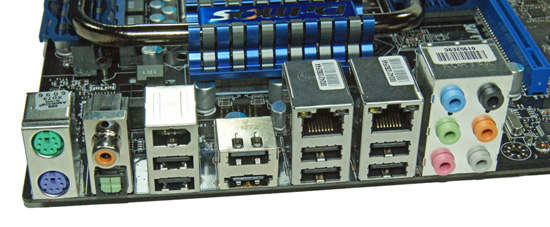
The rear panel features the standard PS/2 mouse and keyboard ports, optical/coaxial S/PDIF out ports, seven USB 2.0 ports, dual Gigabit LAN ports, IEEE 1394a port, audio panel, and a handy eSATA/USB powered combo port.

The Easy Button 2 package is on this particular board. Instead of using the traditional buttons, MSI designed an electromagnetic touch design for the power-on/reset/Green Power (active phase switching tech) functions. Also in this area is the clear CMOS, OC Genie (intelligent auto overclock system and more), Debug panel, and the return of the Base Clock buttons that let you adjust Bclk values in real time on the board.
MSI would greatly appreciate your opinions on this board.
















14 Comments
View All Comments
sanmike - Friday, February 19, 2010 - link
I received an email offering me the credit. The title I was watching when the issue hit I wasn't able to playback on the same pc, however I was able to playback on my netbook. http://www.moviesdownloadsite.net">http://www.moviesdownloadsite.nethttp://www.downloadnewmovies.net">http://www.downloadnewmovies.net
Hard drive - Thursday, December 17, 2009 - link
The board looks great and I am eager to buy one for myself, but I think the price will be more when compared with similar products.http://go.iomega.com/en/products/external-hard-dri...">http://go.iomega.com/en/products/external-hard-dri...
jasonbird - Friday, December 25, 2009 - link
http://www.socheapwholesale.com">http://www.socheapwholesale.comhttp://www.1stjerseys.com">http://www.1stjerseys.com
http://www.socheapwholesale.com/NFL-Jerseys.html">http://www.socheapwholesale.com/NFL-Jerseys.html
http://www.1stjerseys.com/NHL-Jerseys.html">http://www.1stjerseys.com/NHL-Jerseys.html
Taft12 - Wednesday, August 12, 2009 - link
This is a little bit on-topic I guess... How the hell does MSI's naming scheme work? How do they pick the number that comes after the chipset name and what do the letters represent? They've got AMD boards with names like the following?790FX-GD70
790GX-G65
785GM-E65
770-C45
What does it all mean??
rkoth814 - Tuesday, August 18, 2009 - link
Hey there,I'm Rajiv with MSI (Technical Marketing) and I can help shine a little light on the naming scheme.
Normally you'll find the rule is like this:
Chipset-Series-Features-Model
So, for example: 790FX (Chipset) - G (Gaming Series) - D (DrMOS) - 70 (Higher number, better model)
We are looking to make more "user friendly" names for some of our unique boards.
Hope this answered your question.
Etern205 - Tuesday, August 11, 2009 - link
The MSI Big Bang may look the same as this, but one thing the MSI Big Bang has and this doesn't is the Lucid Hydra chip.http://www.techpowerup.com/101405/MSI__Big_Bang__P...">http://www.techpowerup.com/101405/MSI__...otherboa...
cactusdog - Wednesday, August 12, 2009 - link
Ya, big news that wasnt mentioned by Gary. I would really like some testing done on this Gary, or at least some information.gigahertz20 - Wednesday, August 12, 2009 - link
If it really works as well as they say it does, then we're going to see some awesome benchmarks with multiple GPU's.I'm suprised Nvidia or AMD has not gobbled up this small company, maybe they are just waiting to see how well the Hyrdra engine works.
lloverxer - Tuesday, February 22, 2011 - link
Shop Watches, Handbags, Wallets, Clothing, Jewelry & Accessories for Men and Women. Vintage Inspired Watches & Fashion Since 1984. Fossil Official Site.Shop Fossil Men's Watches Collection for Dress Watches, Sport Watches Shop Fossil Women's Watches Collection for Dress Watches, Boyfriend Watches <a href="http://genuinewatchery.info">Fossil Watch</a>Superguy - Tuesday, August 11, 2009 - link
Looks like a good board and may be a viable option.I have to agree with the author, though. What is it about mobo vendors that they're all going with Realtek lately when there's a native Intel LAN adapter built in? I'm guessing it's a little cheaper to implement, but geez, I'd pay a few extra bucks for a quality onboard Intel NIC over that Realtek crap.